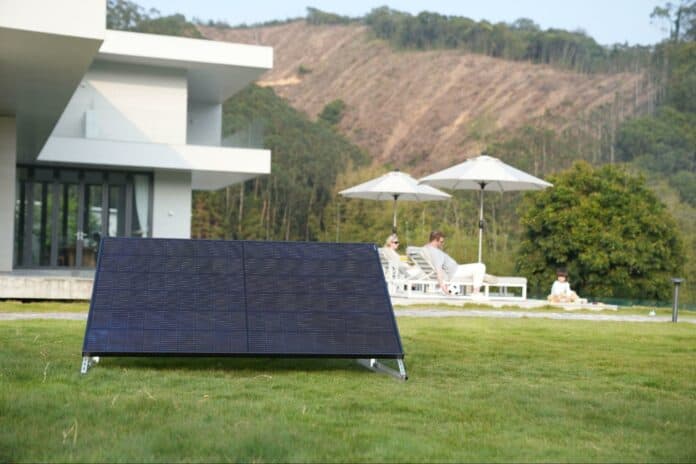Table of Contents
With the shift towards sustainable energy now a global imperative, terms once reserved for textbooks have infiltrated everyday discussions.
One such term is the “photovoltaic effect.”
Photovoltaic is often shortened to PV — as in PV panels. Photovoltaic is pivotal for harnessing solar energy. It holds the secret to converting sunlight into electrical power.
Understanding how the PV effect works provides a clearer picture of the underlying principles behind solar power.
It also helps us appreciate the vast potential of solar technology.
Let’s explore the foundational physics and evolution of this revolutionary technology.
(Source: Energy Education)
The Underlying Physics: How Do Photons Become Electricity?
The science behind the photovoltaic effect intertwines with some of the core principles of modern physics. At the heart of this phenomenon is the photoelectric effect, a process discovered in the early 20th century that laid the foundation for our understanding of quantum mechanics.
The photoelectric effect reveals that when light — composed of packets of energy called photons — interacts with specific materials, it frees electrons from their atomic bonds.
A photon’s energy is directly related to its frequency. Only photons with sufficient energy levels (usually from the visible and ultraviolet spectrum) can dislodge electrons effectively.
In the context of solar cells, photons hitting a photovoltaic surface — typically a semiconductor like monocrystalline or polycrystalline silicon — impart their energy to electrons. Once the electrons gain sufficient power, they become excited and move more freely.
Solar cells employ this principle by using two layers of doped semiconductors. The ‘n-type’ has extra electrons, while the ‘p-type’ has extra “holes.” When the energized electrons from the n-type layer try to return to a more stable state, they are attracted to the p-type’s holes. This organized movement of electrons, driven by the differences between the two layers, results in a direct electric current.
By marrying the principles of the photoelectric effect with clever engineering, the photovoltaic effect captures the sun’s vast energy and converts it into usable electricity.
The elegant fusion of quantum physics and modern electronics is the driving force behind solar energy’s rise as the leading sustainable energy source worldwide.
Evolution and Modern Application of Photovoltaic Technology
The journey of photovoltaic technology is one of innovation and perseverance.
From its humble beginnings in the 19th century, when Alexandre-Edmond Becquerel first observed it, to today’s cutting-edge solar installations, the photovoltaic effect has fueled modern solar innovation.
By the mid-20th century, the space race catalyzed the development of practical solar cells for satellites. These once-costly and inefficient solar cells have transformed into powerful, highly efficient PV panels gracing rooftops and solar farms globally.
Modern photovoltaic cells come in various types, from monocrystalline and polycrystalline silicon to thin-film, each with unique benefits and applications.
Innovations in nanotechnology and materials science have paved the way for even more efficient and flexible solar solutions.
Today, the photovoltaic technology landscape is not limited to powering homes and businesses. Its applications span vast solar farms that produce on-grid electricity, space missions, portable power stations, and even integrated clothing.
As the world shifts course from fossil fuels to clean, renewable energy, photovoltaic technology stands as a beacon of hope, promising cleaner skies and a greener future.
Frequently Asked Questions
The photovoltaic effect is a process in which light (usually sunlight) strikes a material, causing it to absorb photons and release electrons. The release of electrons generates an electric current. Think of it like a dance: when the sun’s rays (the music) hit a solar panel, it gets the electrons (the dancers) moving, producing electricity.
When light interacts with semiconductor material in a solar cell, it excites the electrons within. The energized electrons are pushed out of their normal position, creating an imbalance. Electron movement creates a direct current (DC), which is usually converted to AC (household) electricity. Essentially, the photovoltaic effect transforms sunlight into usable electricity through a dance of particles at the atomic level.
Photovoltaic systems generate direct current (DC) electricity using a physical phenomenon that creates voltage by harvesting photons from light. Semiconductor materials like crystalline silicon wafers are used to create the p-type and n-type junctions needed for electricity production from photovoltaic (PV or solar) cells. Solar panels use multiple PV cells to transmit DC to a solar inverter for AC conversion or a charge controller for battery storage.
The photovoltaic and photoelectric effects use light to produce changes in electrons at the atomic level. The photovoltaic effect excites electrons, knocking them out of their orbit to create electrical potential difference (voltage) and direct current (DC). All solar energy systems that generate electricity use the photovoltaic (PV) effect. PV cells are essential to solar panels. The photoelectric effect ejects electrons from the material’s surface rather than retaining them, producing electric current but not voltage.
Final Thoughts
The photovoltaic effect is a marvel of modern science, seamlessly transforming the sun’s rays into usable electricity.
At its core lies intricate physics, where photons excite electrons, sparking an electric current.
As we’ve journeyed from understanding the photovoltaic effect’s foundational principles to witnessing its revolutionary applications, the impact of PV technology is clear.
If you’re eager to harness sustainable power in daily life, consider adopting state-of-the-art solutions like EcoFlow’s solar panels.
Embrace the sun’s potential to save you money and reduce your carbon footprint today.
